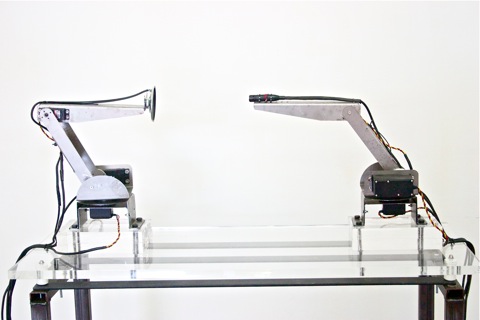
RobertoPugliese
Equilibrium Variant metal, Plexiglas, motors, electronic circuits
80x30x30 cm
2011
This work has the purpose of exploring the occurrence of the Larsen effect (also known as feedback) through the use of mobile devices in a three-dimensional space. The distinctive screech of the Larsen effect typically occurs when a microphone catches the sound emitted by a speaker. It engages when the microphone is located too close to the speaker, and gets in the way of its frequency. The microphone amplifies and reproduces the speaker’s frequency with an ever-increasing width, virtually unlimited, in practice stopped by the amplifier’s clip. On a ground support, two mechanical arms are located. At the end of one arm there is a microphone, and on the end of the other there is a speaker. A software, created with this specific purpose, manages the position of the arms in a dynamic way, and provides that the distance between the microphone and the speaker never causes the amplifier to clip. This way, the system tends to reach an equilibrium that is physically impossible to attain. The struggle to balance creates an acoustic and visual dimension that is never the same: the frequency of feedback and the movements of the mechanical arms are always different and change in real time. In nature, the phenomenon of feedback is the capacity of a system to regulate itself, taking into account the effects of certain modifications to its features. All living beings experience this condition. This project introduces this phenomenon into the world of cybernetics, through the use of sound. Sound makes all the movements extremely harmonic and natural, and the mechanical arms show a movement pattern that is similar to the behavior of living beings, such as two animals fighting or courting. The system changes into a biomechanical organism that has its own life and reacts to external solicitations.
We thank Ing. Walter Pugliese for technical contribution to the realization of the work.
Photos by Thomas Nitz and Marco Gargiulo
RobertoPugliese
Equilibrium Variant metallo, Plexiglas, servomotori, circuiti elettronici
80x30x30 cm
2011
Il lavoro intende indagare sulle potenzialità dello sviluppo dell'effetto Larsen conosciuto anche come feedback, mediante dispositivi mobili in uno spazio tridimensionale. L'effetto Larsen è il tipico fischio stridente che si sviluppa quando i suoni emessi da un altoparlante ritornano ad essere captati da un microfono e si innesca solitamente quando il microfono è troppo vicino all'altoparlante e capta una frequenza emessa da quest'ultimo che, quindi viene amplificata e riprodotta a sua volta con ampiezza via via crescente, virtualmente illimitata, se non fosse che l'amplificatore va in saturazione. Su di un supporto da terra sono posizionati due bracci robotici. Alla estremità di un braccio è posizionato un microfono e sulla estremità dell'altro è posizionato uno speaker. Un software creato ad hoc, dispone la posizione dei bracci robotici nello spazio in maniera dinamica e gestisce la distanza del microfono dallo speaker evitando che il sistema vada in saturazione. In questo modo, il sistema cerca un suo equilibrio ma, questo è fisicamente impossibile da ottenere. La ricerca spasmodica di questo equilibrio crea una dimensione acustica e visiva mutevole dinamicamente in quanto la frequenza del feedback e i movimenti dei bracci sono diversi e mutano in tempo reale. In natura il fenomeno del feedback è la capacità di un sistema di autoregolarsi, tenendo conto degli effetti scaturiti dalla modificazione delle caratteristiche del sistema stesso e tutti gli organismi viventi ne sono soggetti. Il progetto porta questo fenomeno nel campo della cibernetica attraverso il suono; questo rende i movimenti estremamente armonici e naturali ed i bracci assumono caratteristiche comportamentali riconducibili a organismi viventi come per esempio quelle di due animali che si corteggiano o duellano. Il sistema dunque si trasforma in un organismo biomeccanico che vive di vita propria e reagisce alle condizioni esterne.
Si ringrazia l’Ing. Walter Pugliese per il contributo tecnico alla realizzazione dell’opera.
Photos by Thomas Nitz e Marco Gargiulo

